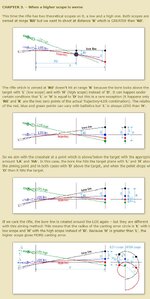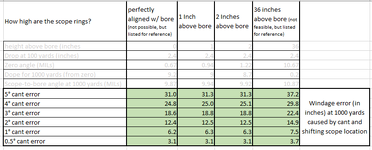I am sure this has been discussed, but seems to have some myth surrounding it, so figured I'd start a new thread to ask specifically. I can find a number of articles on the topic of cant, but few that quantify the error including scope height as a variable. rifle cant causes error at long range--that is not in question. The question is whether a HIGHER scope mount on the same rifle will induce more, less or the same error at long range.
I made a comment in another thread to the effect of "higher scope height increases the error from cant". In response, another poster @JohnJohnson posted an MDT video where they tested this.
The recent discussion was posts 881-891 here: https://rokslide.com/forums/threads/maven-rs1-2-2-5-15x44-new-model.333202/page-45#post-3439453
The MDT video:
The article I posted--note this article is DEBUNKING the "myth" that a higher scope causes more cant error--however, he cites an EXCEPTION to this rule for a rifle with a zero distance that is less than the distance being tested. Apparently he is coming at this from the perspective of fixed, known-distance target shooting, and a situation like having a 100 or 200 yard zero shooting at a target that is at 900 yards is an "exception"... so his conclusion is that scope height doesnt matter, but its not clear to me that he isnt discounting the "exception", which may in fact be more relevant for our purposes. The relevant section of the long and detailed post is screenshot below as well. http://www.szottesfold.co.uk/2012/03/high-scope-and-canting-end-of-ancient.html

from the article:
So, it seems clear from his conclusion that in a situation where you are shooting at a range greater than your zero-distance, he is saying a higher scope WILL increase cant error (bolded section of his conclusion above, as well as his chapter 3).
My questions:
1) are the mdt video and the article at odds? If so, which is correct?
2) what is the FUNCTIONAL difference on target at ranges we shoot? ie if we are talking about a scope with a 1.5" mounting height versus one with a 2.25" mounting height (or whatever realistic min/max is for the sort of hunting rifles folks here are using), zeroed at 100 yards, what is the actual increase in error on target at 500, 600, 800, 1000 yards when we introduce cant error? I dont have the mathing ability to calculate this and could not find any quantified info on the subject beyond what was already referenced.
Edit: I emailed the guy who wrote this article and his reply when I asked to clarify was that if you use a dialed solution, or a reticle-hold, it is the same--in both cases the scope height does not affect the amount of error from cant. He said what he meant was that if you leave your zero as-is and aim using the center crosshair, but aim AT a point on the target above where you want bullet to impact (i.e. you aim at the top of an animal's back or a point above this as a "holdover"), THAT is when a higher scope would amplify the error from any cant.
I made a comment in another thread to the effect of "higher scope height increases the error from cant". In response, another poster @JohnJohnson posted an MDT video where they tested this.
The recent discussion was posts 881-891 here: https://rokslide.com/forums/threads/maven-rs1-2-2-5-15x44-new-model.333202/page-45#post-3439453
The MDT video:
The article I posted--note this article is DEBUNKING the "myth" that a higher scope causes more cant error--however, he cites an EXCEPTION to this rule for a rifle with a zero distance that is less than the distance being tested. Apparently he is coming at this from the perspective of fixed, known-distance target shooting, and a situation like having a 100 or 200 yard zero shooting at a target that is at 900 yards is an "exception"... so his conclusion is that scope height doesnt matter, but its not clear to me that he isnt discounting the "exception", which may in fact be more relevant for our purposes. The relevant section of the long and detailed post is screenshot below as well. http://www.szottesfold.co.uk/2012/03/high-scope-and-canting-end-of-ancient.html

from the article:
PART IV. – CONCLUSIONS
1. In general...
2. If we do the correction outside the scope (i.e. we have zeroed the rifle at a given distance and then shoot at another target with a holdover which is measured at the target), the canting error can be different – more or less – with the higher scopes. It will be more if the new range is greater than the zero range and less if it's shorter.
....
So, it seems clear from his conclusion that in a situation where you are shooting at a range greater than your zero-distance, he is saying a higher scope WILL increase cant error (bolded section of his conclusion above, as well as his chapter 3).
My questions:
1) are the mdt video and the article at odds? If so, which is correct?
2) what is the FUNCTIONAL difference on target at ranges we shoot? ie if we are talking about a scope with a 1.5" mounting height versus one with a 2.25" mounting height (or whatever realistic min/max is for the sort of hunting rifles folks here are using), zeroed at 100 yards, what is the actual increase in error on target at 500, 600, 800, 1000 yards when we introduce cant error? I dont have the mathing ability to calculate this and could not find any quantified info on the subject beyond what was already referenced.
Edit: I emailed the guy who wrote this article and his reply when I asked to clarify was that if you use a dialed solution, or a reticle-hold, it is the same--in both cases the scope height does not affect the amount of error from cant. He said what he meant was that if you leave your zero as-is and aim using the center crosshair, but aim AT a point on the target above where you want bullet to impact (i.e. you aim at the top of an animal's back or a point above this as a "holdover"), THAT is when a higher scope would amplify the error from any cant.
Last edited:

